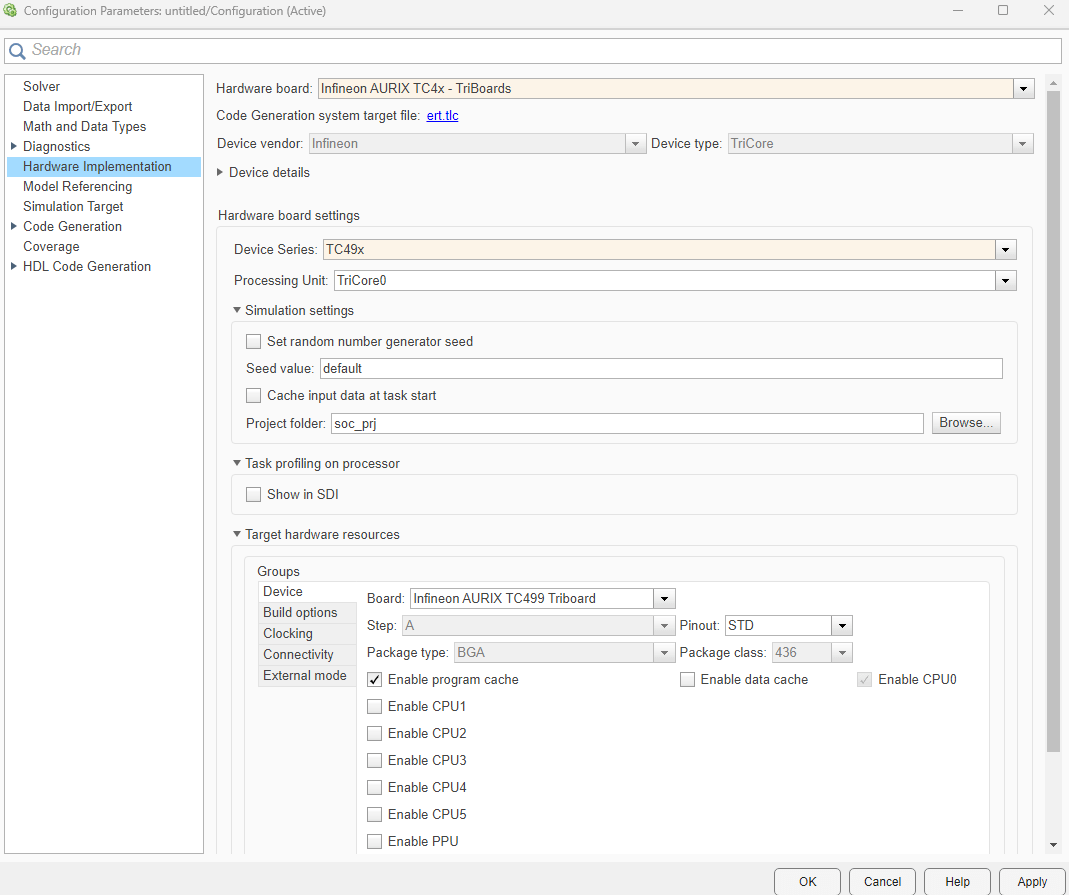Model Configuration Parameters
Update the configuration parameters for a Simulink® model that you create, before simulating or deploying the model to the microcontroller.
In the Simulink window, click Hardware Settings in the HARDWARE tab to open the Configuration Parameters dialog box and select the target hardware in the Hardware board field. You can also press Ctrl+E to open the Configuration Parameters dialog box.

Hardware Implementation Pane Overview

Configure hardware board to run Simulink models.
In the Simulink Editor, select Simulation > Model Configuration Parameters.
In the Configuration Parameter dialog box, click Hardware Implementation.
Set the Hardware board parameter to
Infineon AURIX TC4x - TriBoards.The parameter values under Hardware board settings are automatically populated to their default values.
To apply the changes, click Apply.
Simulation settings
| Parameter | Description | Default Value |
|---|---|---|
Set the random number generator seed. |
| |
Specify the seed value for random number generator. |
| |
Cache the input data at the start of a task. |
| |
Select project folder to store generated code and executables |
|
Task profiling on processor
| Parameter | Description | Default Value |
|---|---|---|
Show the task execution data collected on hardware in the Simulation Data Inspector application. | off |
Target hardware resources
Device
| Parameter | Description | Default Value |
|---|---|---|
| Device Series | Displays the device series for the selected hardware board. |
|
| Processing Unit | Processing unit to build and deploy the application model. | TriCore0 |
| Board | Hardware board of the selected device series | Infineon AURIX TC499 Triboard |
| Step | Displays the device step for the selected hardware board. |
|
| Package type | Displays the device packaging type for the selected hardware. |
|
| Package class | Displays the number of programmable pins for the selected hardware board/microcontrollers. You can set the package class to 436 or 292. |
|
| Pinout | Displays the pinout type for the selected hardware board. You can set the package class to STD or COM. |
|
| Enable CPU# | Select the CPU. |
|
| Enable program cache | Select the program cache. |
|
| Enable data cache | Select the data cache. |
|
Build Options
| Parameter | Description | Default Value |
|---|---|---|
| Build action | Define how Embedded Coder® responds when you build your model. |
|
| Disable parallel build | Select to compile the generated code and driver source codes in parallel order for faster build and deployment speed. | off |
| Enable force rebuild of static library | Select to force rebuild of the static driver library. |
|
| Boot From | Option to specify if the application has to load to the RAM or ROM. |
|
| Use custom linker file | Indicates that the custom linker command file must be used during the build action. |
|
| Linker file | The path to the memory description file required during linking. |
|
Clocking
| Parameter | Description | Default Value |
|---|---|---|
Oscillator frequency used in the processor. |
| |
CPU clock frequency of the microcontrollers on the target hardware |
|
Connectivity
| Parameter | Description | Default Value |
|---|---|---|
| Connectivity interface | Select the type of communication interface for simulation. | Serial (ASCLIN0) |
| Port | Select the serial communication interface module. | empty |
| Baud Rate | Select the baud rate of the serial communication port. | 921600 |
External mode
| Parameter | Description | Default Value |
|---|---|---|
| Communication interface | Select the transport layer External mode uses to exchange data between the host computer and the target hardware | Serial |
| Verbose | Select Verbose to view the External mode execution progress and updates. | off |